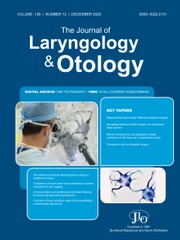No CrossRef data available.
Article contents
Endoscopic transoral approach to the parapharyngeal space: technical nuances and preliminary results
Published online by Cambridge University Press: 06 July 2022
Abstract
Surgical management is the mainstay of treatment for tumours in the parapharyngeal space. This study aimed to evaluate the indications, limits and technical nuances of the endoscopic transoral approach.
Thirteen patients with parapharyngeal space tumours that were treated between May 2017 and November 2020 were included in this retrospective study.
All patients underwent surgery for complete oncological resection except one patient who received treatment for diagnostic purposes. No major complications were reported, with excellent control of the vital structures of the parapharyngeal space.
The endoscopic transoral approach to the parapharyngeal space is a promising alternative approach for selected parapharyngeal space tumours with satisfactory outcomes.
- Type
- Main Article
- Information
- Copyright
- Copyright © The Author(s), 2022. Published by Cambridge University Press on behalf of J.L.O. (1984) LIMITED
Footnotes
Dr X-C Sun takes responsibility for the integrity of the content of the paper
J Liu and Q Liu contributed equally to this work as first authors
X-C Sun, H-M Yu and D-H Wang contributed equally to this work as corresponding authors




